Unit 01 Principles of Business: A Case Study of Marks and Spencer
VerifiedAdded on 2024/05/15
|11
|3051
|62
AI Summary
This report explores the fundamental principles of business through a case study of Marks and Spencer, a renowned British retail company. It delves into the characteristics of business markets, the nature of interactions between businesses, and how an organization's goals are shaped by its market. The report further examines business innovation, its models, sources of support, and the process of product development. It also discusses the importance of financial viability, the consequences of poor financial management, and different financial terminologies. Finally, the report explores the principles of marketing, the sales process, market research, the value of branding, and the relationship between sales and marketing.
Contribute Materials
Your contribution can guide someone’s learning journey. Share your
documents today.
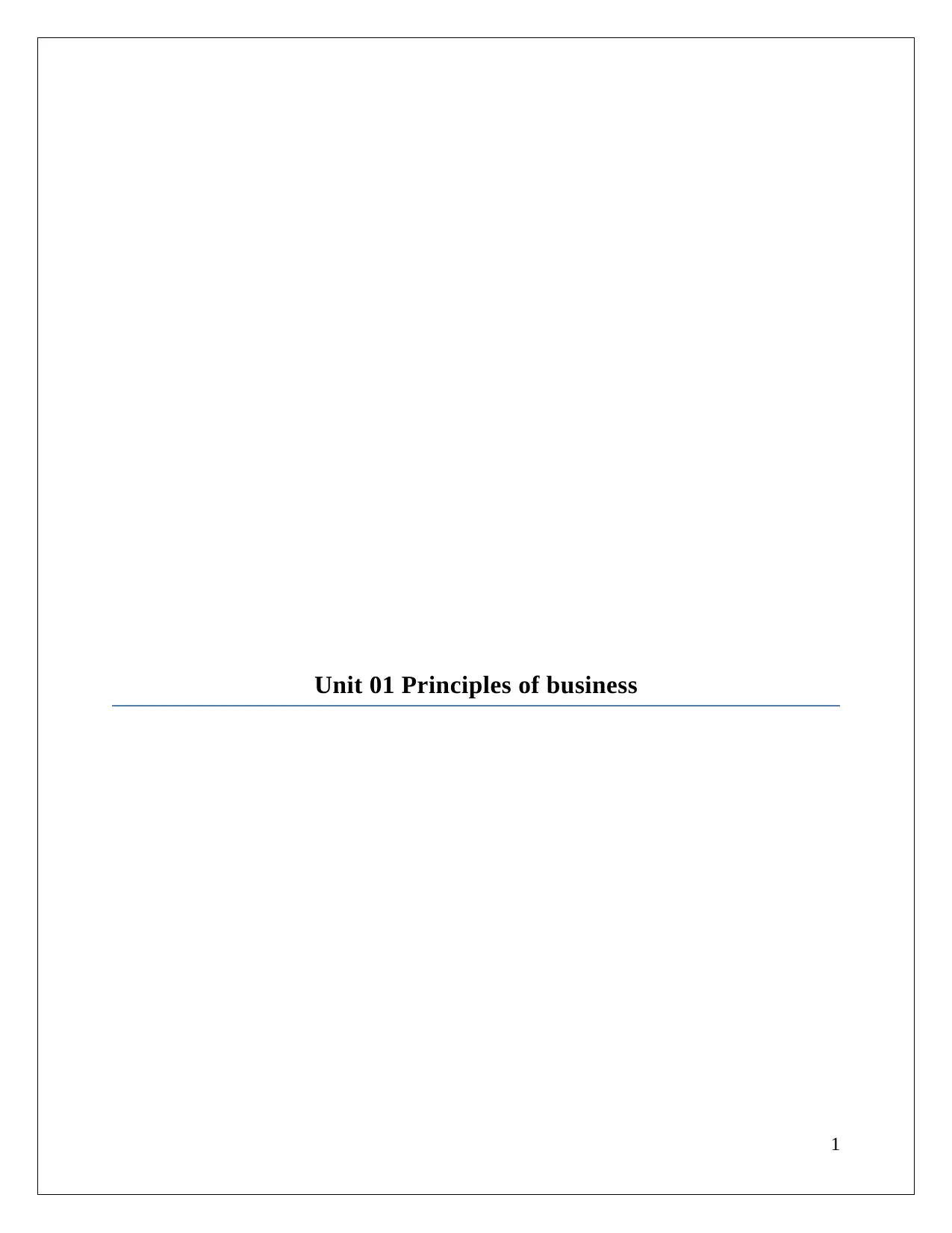
Unit 01 Principles of business
1
1
Secure Best Marks with AI Grader
Need help grading? Try our AI Grader for instant feedback on your assignments.
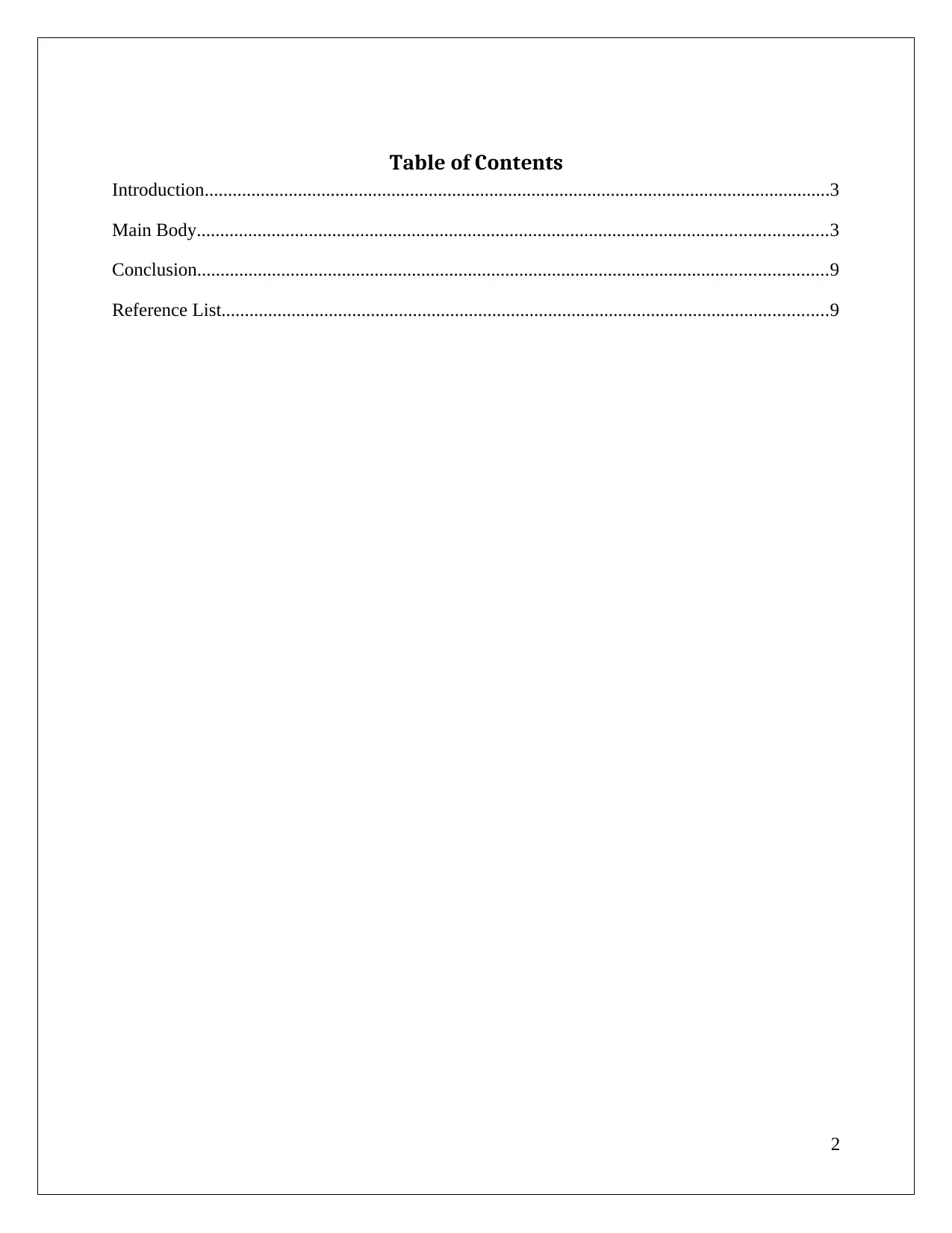
Table of Contents
Introduction......................................................................................................................................3
Main Body.......................................................................................................................................3
Conclusion.......................................................................................................................................9
Reference List..................................................................................................................................9
2
Introduction......................................................................................................................................3
Main Body.......................................................................................................................................3
Conclusion.......................................................................................................................................9
Reference List..................................................................................................................................9
2
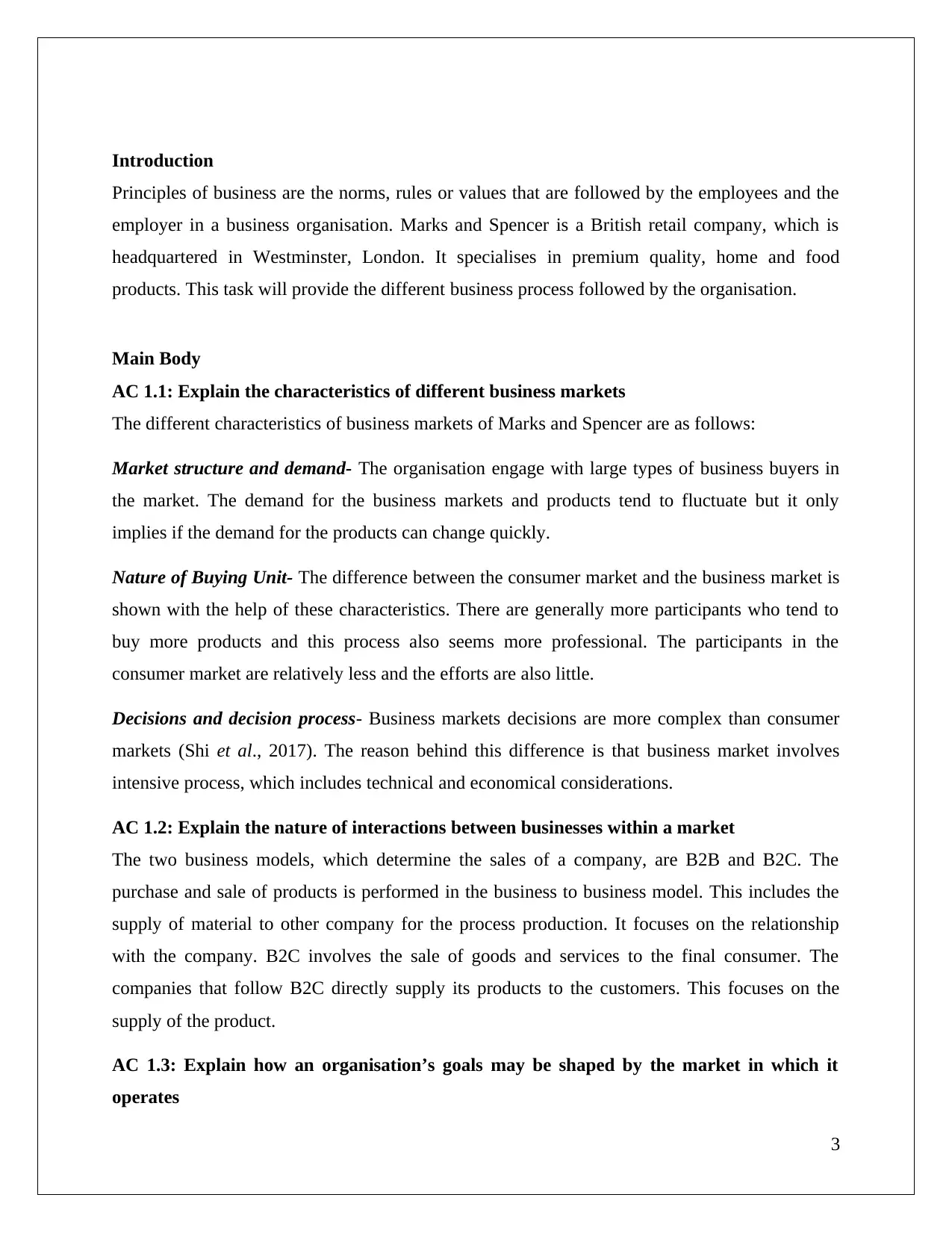
Introduction
Principles of business are the norms, rules or values that are followed by the employees and the
employer in a business organisation. Marks and Spencer is a British retail company, which is
headquartered in Westminster, London. It specialises in premium quality, home and food
products. This task will provide the different business process followed by the organisation.
Main Body
AC 1.1: Explain the characteristics of different business markets
The different characteristics of business markets of Marks and Spencer are as follows:
Market structure and demand- The organisation engage with large types of business buyers in
the market. The demand for the business markets and products tend to fluctuate but it only
implies if the demand for the products can change quickly.
Nature of Buying Unit- The difference between the consumer market and the business market is
shown with the help of these characteristics. There are generally more participants who tend to
buy more products and this process also seems more professional. The participants in the
consumer market are relatively less and the efforts are also little.
Decisions and decision process- Business markets decisions are more complex than consumer
markets (Shi et al., 2017). The reason behind this difference is that business market involves
intensive process, which includes technical and economical considerations.
AC 1.2: Explain the nature of interactions between businesses within a market
The two business models, which determine the sales of a company, are B2B and B2C. The
purchase and sale of products is performed in the business to business model. This includes the
supply of material to other company for the process production. It focuses on the relationship
with the company. B2C involves the sale of goods and services to the final consumer. The
companies that follow B2C directly supply its products to the customers. This focuses on the
supply of the product.
AC 1.3: Explain how an organisation’s goals may be shaped by the market in which it
operates
3
Principles of business are the norms, rules or values that are followed by the employees and the
employer in a business organisation. Marks and Spencer is a British retail company, which is
headquartered in Westminster, London. It specialises in premium quality, home and food
products. This task will provide the different business process followed by the organisation.
Main Body
AC 1.1: Explain the characteristics of different business markets
The different characteristics of business markets of Marks and Spencer are as follows:
Market structure and demand- The organisation engage with large types of business buyers in
the market. The demand for the business markets and products tend to fluctuate but it only
implies if the demand for the products can change quickly.
Nature of Buying Unit- The difference between the consumer market and the business market is
shown with the help of these characteristics. There are generally more participants who tend to
buy more products and this process also seems more professional. The participants in the
consumer market are relatively less and the efforts are also little.
Decisions and decision process- Business markets decisions are more complex than consumer
markets (Shi et al., 2017). The reason behind this difference is that business market involves
intensive process, which includes technical and economical considerations.
AC 1.2: Explain the nature of interactions between businesses within a market
The two business models, which determine the sales of a company, are B2B and B2C. The
purchase and sale of products is performed in the business to business model. This includes the
supply of material to other company for the process production. It focuses on the relationship
with the company. B2C involves the sale of goods and services to the final consumer. The
companies that follow B2C directly supply its products to the customers. This focuses on the
supply of the product.
AC 1.3: Explain how an organisation’s goals may be shaped by the market in which it
operates
3
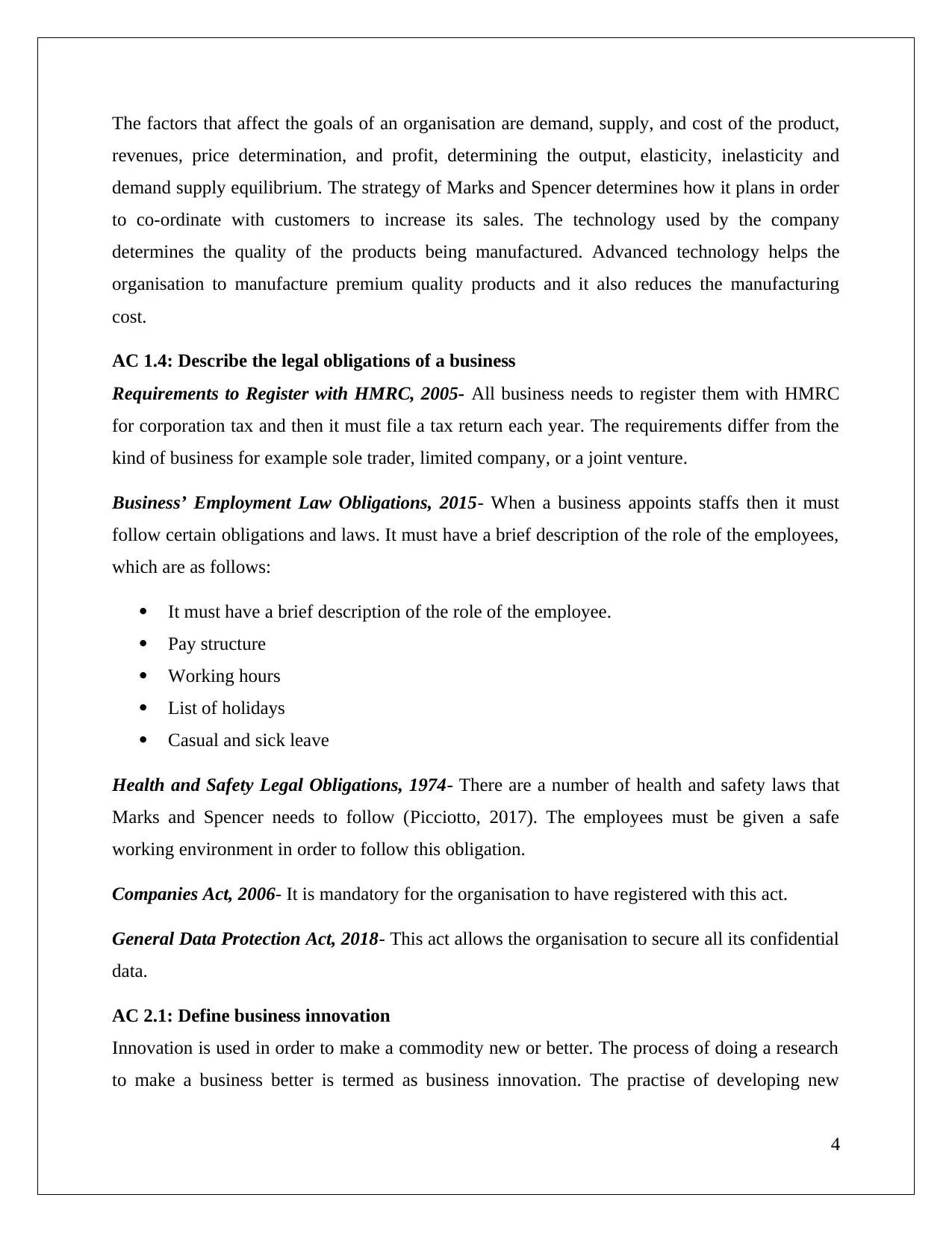
The factors that affect the goals of an organisation are demand, supply, and cost of the product,
revenues, price determination, and profit, determining the output, elasticity, inelasticity and
demand supply equilibrium. The strategy of Marks and Spencer determines how it plans in order
to co-ordinate with customers to increase its sales. The technology used by the company
determines the quality of the products being manufactured. Advanced technology helps the
organisation to manufacture premium quality products and it also reduces the manufacturing
cost.
AC 1.4: Describe the legal obligations of a business
Requirements to Register with HMRC, 2005- All business needs to register them with HMRC
for corporation tax and then it must file a tax return each year. The requirements differ from the
kind of business for example sole trader, limited company, or a joint venture.
Business’ Employment Law Obligations, 2015- When a business appoints staffs then it must
follow certain obligations and laws. It must have a brief description of the role of the employees,
which are as follows:
It must have a brief description of the role of the employee.
Pay structure
Working hours
List of holidays
Casual and sick leave
Health and Safety Legal Obligations, 1974- There are a number of health and safety laws that
Marks and Spencer needs to follow (Picciotto, 2017). The employees must be given a safe
working environment in order to follow this obligation.
Companies Act, 2006- It is mandatory for the organisation to have registered with this act.
General Data Protection Act, 2018- This act allows the organisation to secure all its confidential
data.
AC 2.1: Define business innovation
Innovation is used in order to make a commodity new or better. The process of doing a research
to make a business better is termed as business innovation. The practise of developing new
4
revenues, price determination, and profit, determining the output, elasticity, inelasticity and
demand supply equilibrium. The strategy of Marks and Spencer determines how it plans in order
to co-ordinate with customers to increase its sales. The technology used by the company
determines the quality of the products being manufactured. Advanced technology helps the
organisation to manufacture premium quality products and it also reduces the manufacturing
cost.
AC 1.4: Describe the legal obligations of a business
Requirements to Register with HMRC, 2005- All business needs to register them with HMRC
for corporation tax and then it must file a tax return each year. The requirements differ from the
kind of business for example sole trader, limited company, or a joint venture.
Business’ Employment Law Obligations, 2015- When a business appoints staffs then it must
follow certain obligations and laws. It must have a brief description of the role of the employees,
which are as follows:
It must have a brief description of the role of the employee.
Pay structure
Working hours
List of holidays
Casual and sick leave
Health and Safety Legal Obligations, 1974- There are a number of health and safety laws that
Marks and Spencer needs to follow (Picciotto, 2017). The employees must be given a safe
working environment in order to follow this obligation.
Companies Act, 2006- It is mandatory for the organisation to have registered with this act.
General Data Protection Act, 2018- This act allows the organisation to secure all its confidential
data.
AC 2.1: Define business innovation
Innovation is used in order to make a commodity new or better. The process of doing a research
to make a business better is termed as business innovation. The practise of developing new
4
Secure Best Marks with AI Grader
Need help grading? Try our AI Grader for instant feedback on your assignments.
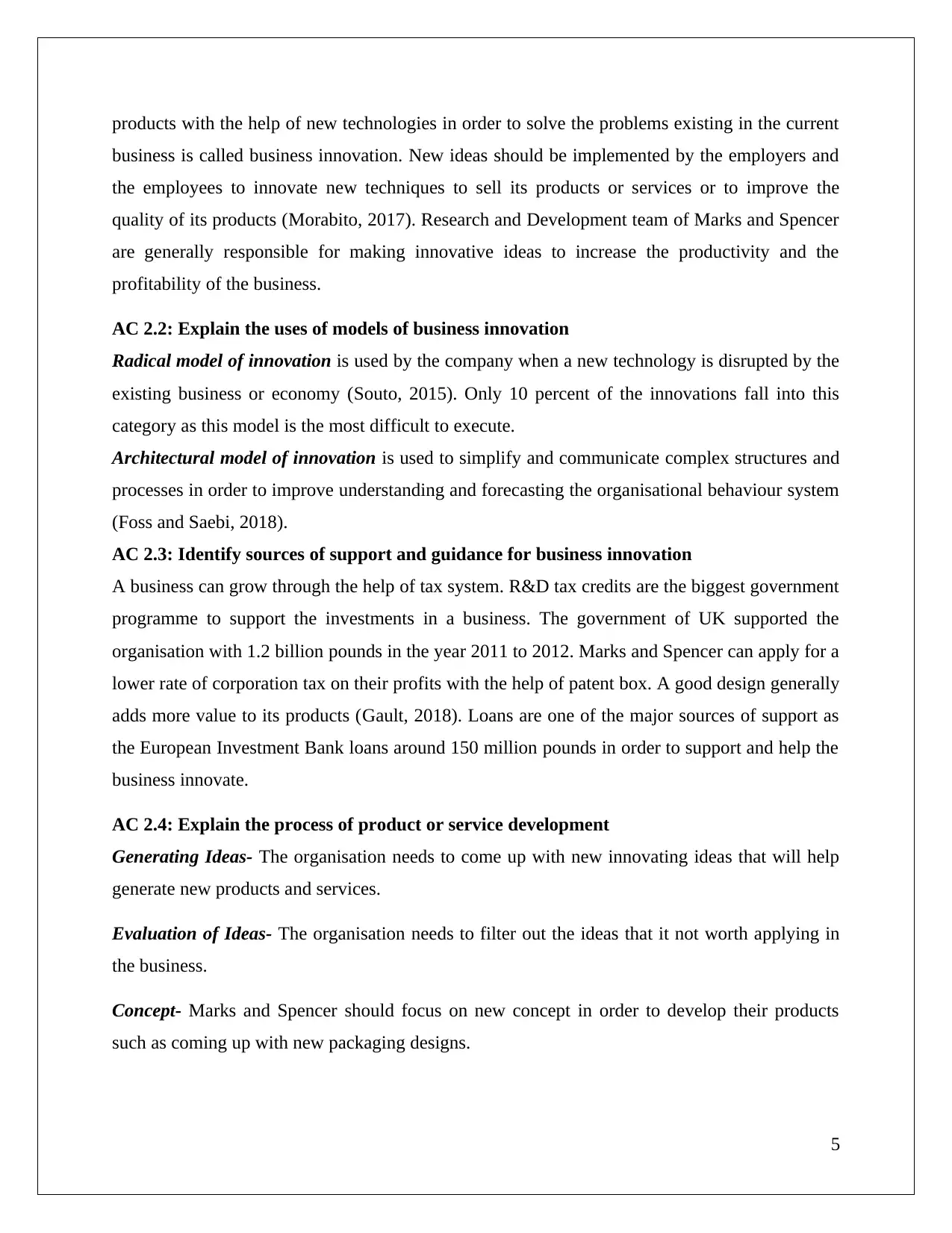
products with the help of new technologies in order to solve the problems existing in the current
business is called business innovation. New ideas should be implemented by the employers and
the employees to innovate new techniques to sell its products or services or to improve the
quality of its products (Morabito, 2017). Research and Development team of Marks and Spencer
are generally responsible for making innovative ideas to increase the productivity and the
profitability of the business.
AC 2.2: Explain the uses of models of business innovation
Radical model of innovation is used by the company when a new technology is disrupted by the
existing business or economy (Souto, 2015). Only 10 percent of the innovations fall into this
category as this model is the most difficult to execute.
Architectural model of innovation is used to simplify and communicate complex structures and
processes in order to improve understanding and forecasting the organisational behaviour system
(Foss and Saebi, 2018).
AC 2.3: Identify sources of support and guidance for business innovation
A business can grow through the help of tax system. R&D tax credits are the biggest government
programme to support the investments in a business. The government of UK supported the
organisation with 1.2 billion pounds in the year 2011 to 2012. Marks and Spencer can apply for a
lower rate of corporation tax on their profits with the help of patent box. A good design generally
adds more value to its products (Gault, 2018). Loans are one of the major sources of support as
the European Investment Bank loans around 150 million pounds in order to support and help the
business innovate.
AC 2.4: Explain the process of product or service development
Generating Ideas- The organisation needs to come up with new innovating ideas that will help
generate new products and services.
Evaluation of Ideas- The organisation needs to filter out the ideas that it not worth applying in
the business.
Concept- Marks and Spencer should focus on new concept in order to develop their products
such as coming up with new packaging designs.
5
business is called business innovation. New ideas should be implemented by the employers and
the employees to innovate new techniques to sell its products or services or to improve the
quality of its products (Morabito, 2017). Research and Development team of Marks and Spencer
are generally responsible for making innovative ideas to increase the productivity and the
profitability of the business.
AC 2.2: Explain the uses of models of business innovation
Radical model of innovation is used by the company when a new technology is disrupted by the
existing business or economy (Souto, 2015). Only 10 percent of the innovations fall into this
category as this model is the most difficult to execute.
Architectural model of innovation is used to simplify and communicate complex structures and
processes in order to improve understanding and forecasting the organisational behaviour system
(Foss and Saebi, 2018).
AC 2.3: Identify sources of support and guidance for business innovation
A business can grow through the help of tax system. R&D tax credits are the biggest government
programme to support the investments in a business. The government of UK supported the
organisation with 1.2 billion pounds in the year 2011 to 2012. Marks and Spencer can apply for a
lower rate of corporation tax on their profits with the help of patent box. A good design generally
adds more value to its products (Gault, 2018). Loans are one of the major sources of support as
the European Investment Bank loans around 150 million pounds in order to support and help the
business innovate.
AC 2.4: Explain the process of product or service development
Generating Ideas- The organisation needs to come up with new innovating ideas that will help
generate new products and services.
Evaluation of Ideas- The organisation needs to filter out the ideas that it not worth applying in
the business.
Concept- Marks and Spencer should focus on new concept in order to develop their products
such as coming up with new packaging designs.
5
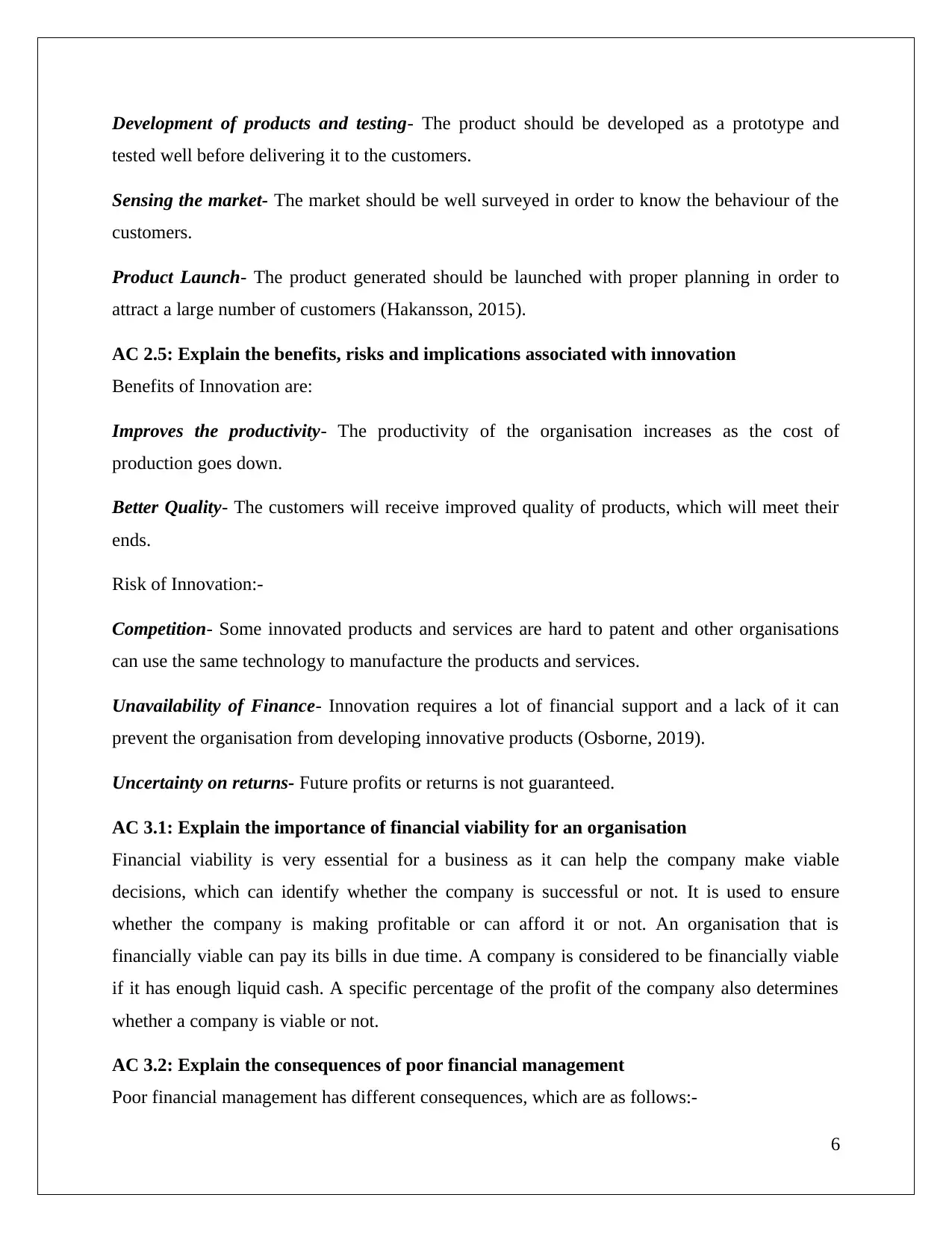
Development of products and testing- The product should be developed as a prototype and
tested well before delivering it to the customers.
Sensing the market- The market should be well surveyed in order to know the behaviour of the
customers.
Product Launch- The product generated should be launched with proper planning in order to
attract a large number of customers (Hakansson, 2015).
AC 2.5: Explain the benefits, risks and implications associated with innovation
Benefits of Innovation are:
Improves the productivity- The productivity of the organisation increases as the cost of
production goes down.
Better Quality- The customers will receive improved quality of products, which will meet their
ends.
Risk of Innovation:-
Competition- Some innovated products and services are hard to patent and other organisations
can use the same technology to manufacture the products and services.
Unavailability of Finance- Innovation requires a lot of financial support and a lack of it can
prevent the organisation from developing innovative products (Osborne, 2019).
Uncertainty on returns- Future profits or returns is not guaranteed.
AC 3.1: Explain the importance of financial viability for an organisation
Financial viability is very essential for a business as it can help the company make viable
decisions, which can identify whether the company is successful or not. It is used to ensure
whether the company is making profitable or can afford it or not. An organisation that is
financially viable can pay its bills in due time. A company is considered to be financially viable
if it has enough liquid cash. A specific percentage of the profit of the company also determines
whether a company is viable or not.
AC 3.2: Explain the consequences of poor financial management
Poor financial management has different consequences, which are as follows:-
6
tested well before delivering it to the customers.
Sensing the market- The market should be well surveyed in order to know the behaviour of the
customers.
Product Launch- The product generated should be launched with proper planning in order to
attract a large number of customers (Hakansson, 2015).
AC 2.5: Explain the benefits, risks and implications associated with innovation
Benefits of Innovation are:
Improves the productivity- The productivity of the organisation increases as the cost of
production goes down.
Better Quality- The customers will receive improved quality of products, which will meet their
ends.
Risk of Innovation:-
Competition- Some innovated products and services are hard to patent and other organisations
can use the same technology to manufacture the products and services.
Unavailability of Finance- Innovation requires a lot of financial support and a lack of it can
prevent the organisation from developing innovative products (Osborne, 2019).
Uncertainty on returns- Future profits or returns is not guaranteed.
AC 3.1: Explain the importance of financial viability for an organisation
Financial viability is very essential for a business as it can help the company make viable
decisions, which can identify whether the company is successful or not. It is used to ensure
whether the company is making profitable or can afford it or not. An organisation that is
financially viable can pay its bills in due time. A company is considered to be financially viable
if it has enough liquid cash. A specific percentage of the profit of the company also determines
whether a company is viable or not.
AC 3.2: Explain the consequences of poor financial management
Poor financial management has different consequences, which are as follows:-
6
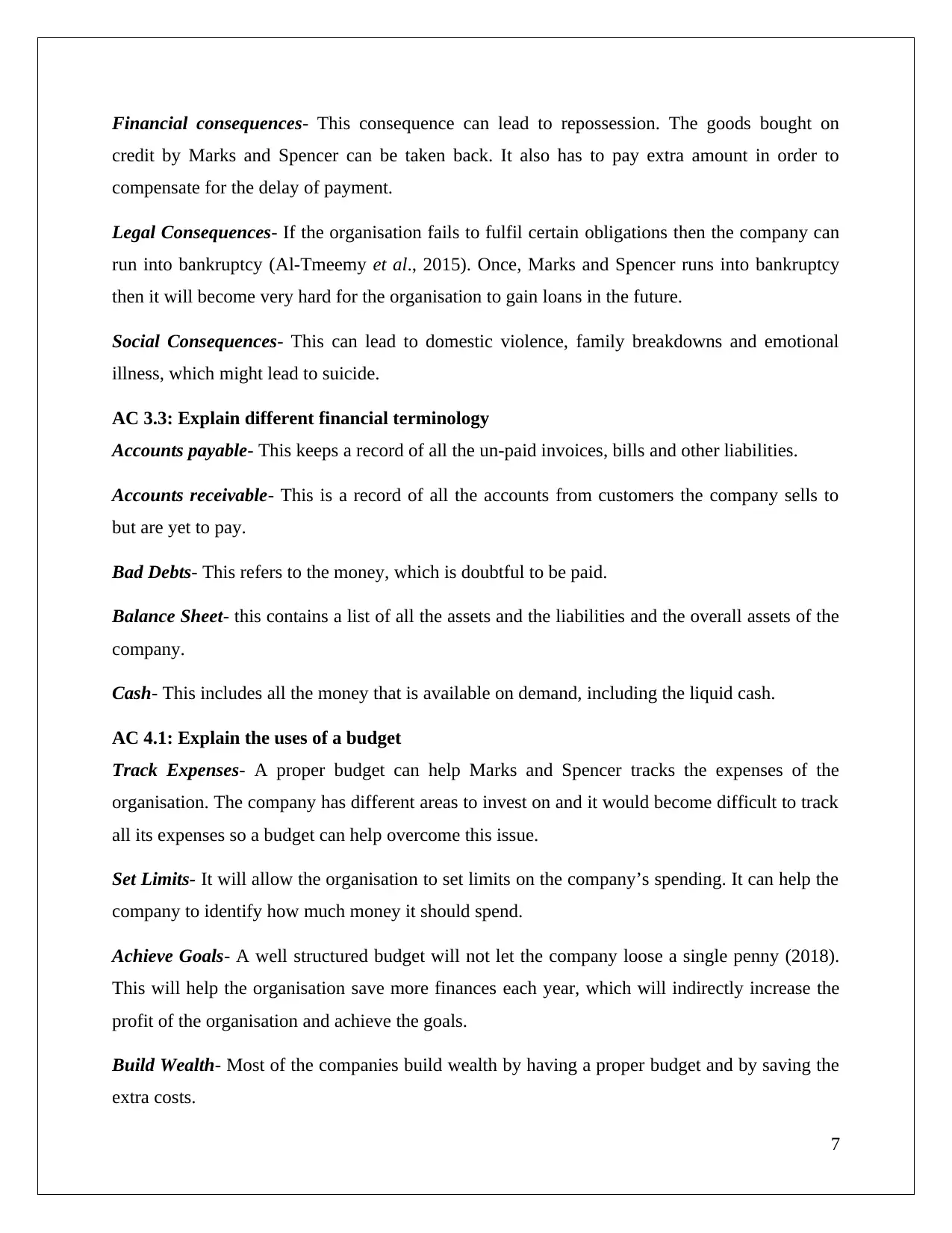
Financial consequences- This consequence can lead to repossession. The goods bought on
credit by Marks and Spencer can be taken back. It also has to pay extra amount in order to
compensate for the delay of payment.
Legal Consequences- If the organisation fails to fulfil certain obligations then the company can
run into bankruptcy (Al-Tmeemy et al., 2015). Once, Marks and Spencer runs into bankruptcy
then it will become very hard for the organisation to gain loans in the future.
Social Consequences- This can lead to domestic violence, family breakdowns and emotional
illness, which might lead to suicide.
AC 3.3: Explain different financial terminology
Accounts payable- This keeps a record of all the un-paid invoices, bills and other liabilities.
Accounts receivable- This is a record of all the accounts from customers the company sells to
but are yet to pay.
Bad Debts- This refers to the money, which is doubtful to be paid.
Balance Sheet- this contains a list of all the assets and the liabilities and the overall assets of the
company.
Cash- This includes all the money that is available on demand, including the liquid cash.
AC 4.1: Explain the uses of a budget
Track Expenses- A proper budget can help Marks and Spencer tracks the expenses of the
organisation. The company has different areas to invest on and it would become difficult to track
all its expenses so a budget can help overcome this issue.
Set Limits- It will allow the organisation to set limits on the company’s spending. It can help the
company to identify how much money it should spend.
Achieve Goals- A well structured budget will not let the company loose a single penny (2018).
This will help the organisation save more finances each year, which will indirectly increase the
profit of the organisation and achieve the goals.
Build Wealth- Most of the companies build wealth by having a proper budget and by saving the
extra costs.
7
credit by Marks and Spencer can be taken back. It also has to pay extra amount in order to
compensate for the delay of payment.
Legal Consequences- If the organisation fails to fulfil certain obligations then the company can
run into bankruptcy (Al-Tmeemy et al., 2015). Once, Marks and Spencer runs into bankruptcy
then it will become very hard for the organisation to gain loans in the future.
Social Consequences- This can lead to domestic violence, family breakdowns and emotional
illness, which might lead to suicide.
AC 3.3: Explain different financial terminology
Accounts payable- This keeps a record of all the un-paid invoices, bills and other liabilities.
Accounts receivable- This is a record of all the accounts from customers the company sells to
but are yet to pay.
Bad Debts- This refers to the money, which is doubtful to be paid.
Balance Sheet- this contains a list of all the assets and the liabilities and the overall assets of the
company.
Cash- This includes all the money that is available on demand, including the liquid cash.
AC 4.1: Explain the uses of a budget
Track Expenses- A proper budget can help Marks and Spencer tracks the expenses of the
organisation. The company has different areas to invest on and it would become difficult to track
all its expenses so a budget can help overcome this issue.
Set Limits- It will allow the organisation to set limits on the company’s spending. It can help the
company to identify how much money it should spend.
Achieve Goals- A well structured budget will not let the company loose a single penny (2018).
This will help the organisation save more finances each year, which will indirectly increase the
profit of the organisation and achieve the goals.
Build Wealth- Most of the companies build wealth by having a proper budget and by saving the
extra costs.
7
Paraphrase This Document
Need a fresh take? Get an instant paraphrase of this document with our AI Paraphraser
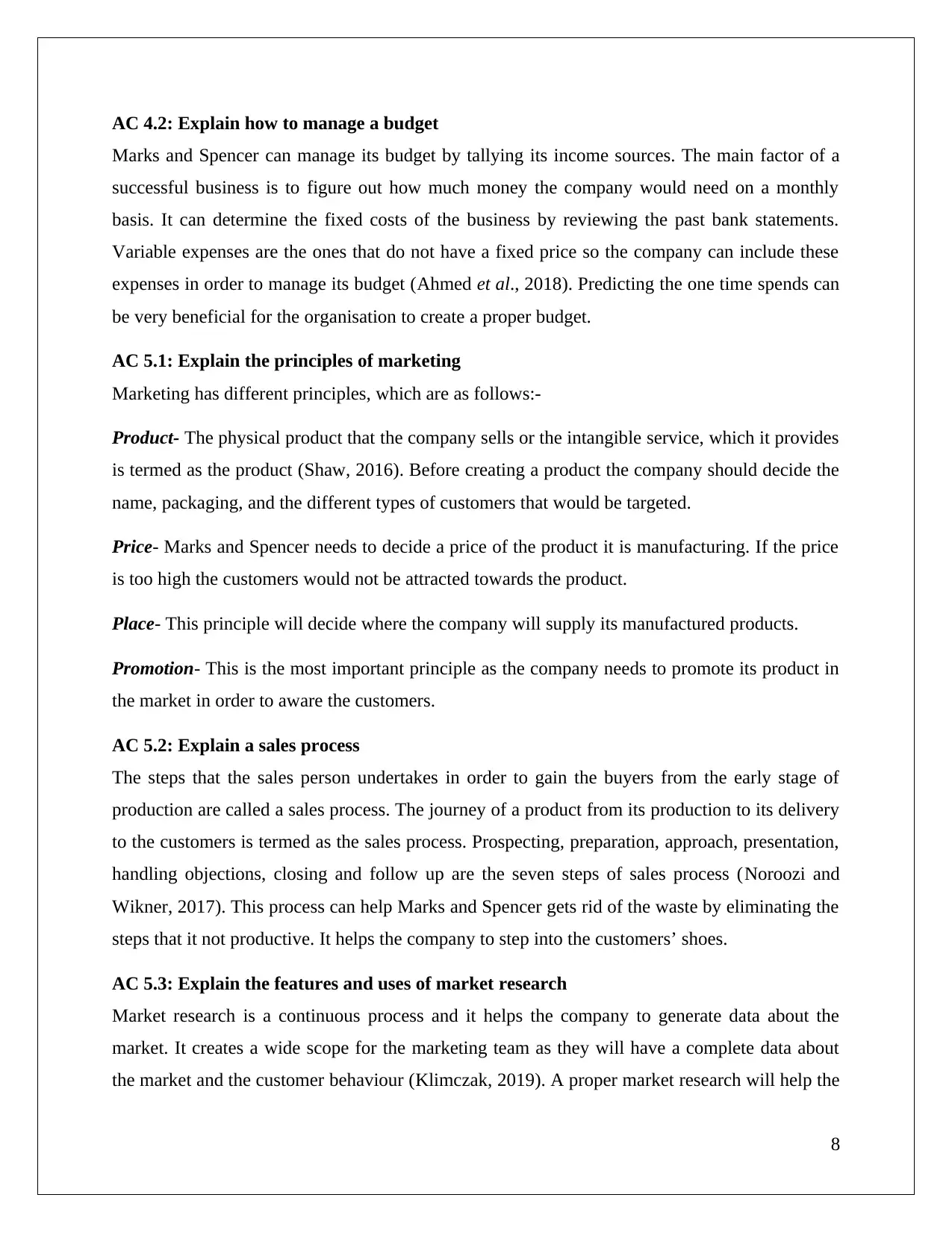
AC 4.2: Explain how to manage a budget
Marks and Spencer can manage its budget by tallying its income sources. The main factor of a
successful business is to figure out how much money the company would need on a monthly
basis. It can determine the fixed costs of the business by reviewing the past bank statements.
Variable expenses are the ones that do not have a fixed price so the company can include these
expenses in order to manage its budget (Ahmed et al., 2018). Predicting the one time spends can
be very beneficial for the organisation to create a proper budget.
AC 5.1: Explain the principles of marketing
Marketing has different principles, which are as follows:-
Product- The physical product that the company sells or the intangible service, which it provides
is termed as the product (Shaw, 2016). Before creating a product the company should decide the
name, packaging, and the different types of customers that would be targeted.
Price- Marks and Spencer needs to decide a price of the product it is manufacturing. If the price
is too high the customers would not be attracted towards the product.
Place- This principle will decide where the company will supply its manufactured products.
Promotion- This is the most important principle as the company needs to promote its product in
the market in order to aware the customers.
AC 5.2: Explain a sales process
The steps that the sales person undertakes in order to gain the buyers from the early stage of
production are called a sales process. The journey of a product from its production to its delivery
to the customers is termed as the sales process. Prospecting, preparation, approach, presentation,
handling objections, closing and follow up are the seven steps of sales process (Noroozi and
Wikner, 2017). This process can help Marks and Spencer gets rid of the waste by eliminating the
steps that it not productive. It helps the company to step into the customers’ shoes.
AC 5.3: Explain the features and uses of market research
Market research is a continuous process and it helps the company to generate data about the
market. It creates a wide scope for the marketing team as they will have a complete data about
the market and the customer behaviour (Klimczak, 2019). A proper market research will help the
8
Marks and Spencer can manage its budget by tallying its income sources. The main factor of a
successful business is to figure out how much money the company would need on a monthly
basis. It can determine the fixed costs of the business by reviewing the past bank statements.
Variable expenses are the ones that do not have a fixed price so the company can include these
expenses in order to manage its budget (Ahmed et al., 2018). Predicting the one time spends can
be very beneficial for the organisation to create a proper budget.
AC 5.1: Explain the principles of marketing
Marketing has different principles, which are as follows:-
Product- The physical product that the company sells or the intangible service, which it provides
is termed as the product (Shaw, 2016). Before creating a product the company should decide the
name, packaging, and the different types of customers that would be targeted.
Price- Marks and Spencer needs to decide a price of the product it is manufacturing. If the price
is too high the customers would not be attracted towards the product.
Place- This principle will decide where the company will supply its manufactured products.
Promotion- This is the most important principle as the company needs to promote its product in
the market in order to aware the customers.
AC 5.2: Explain a sales process
The steps that the sales person undertakes in order to gain the buyers from the early stage of
production are called a sales process. The journey of a product from its production to its delivery
to the customers is termed as the sales process. Prospecting, preparation, approach, presentation,
handling objections, closing and follow up are the seven steps of sales process (Noroozi and
Wikner, 2017). This process can help Marks and Spencer gets rid of the waste by eliminating the
steps that it not productive. It helps the company to step into the customers’ shoes.
AC 5.3: Explain the features and uses of market research
Market research is a continuous process and it helps the company to generate data about the
market. It creates a wide scope for the marketing team as they will have a complete data about
the market and the customer behaviour (Klimczak, 2019). A proper market research will help the
8
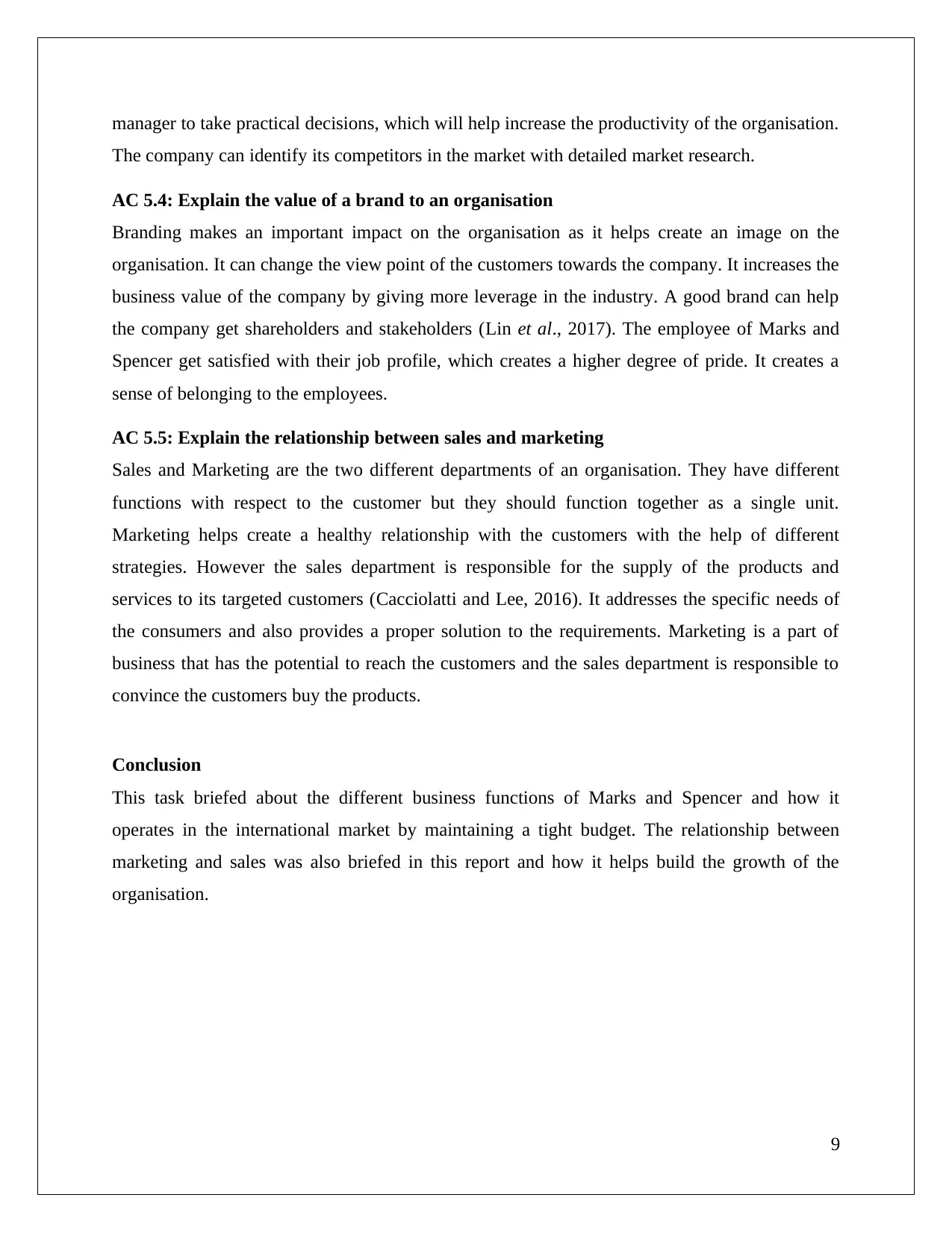
manager to take practical decisions, which will help increase the productivity of the organisation.
The company can identify its competitors in the market with detailed market research.
AC 5.4: Explain the value of a brand to an organisation
Branding makes an important impact on the organisation as it helps create an image on the
organisation. It can change the view point of the customers towards the company. It increases the
business value of the company by giving more leverage in the industry. A good brand can help
the company get shareholders and stakeholders (Lin et al., 2017). The employee of Marks and
Spencer get satisfied with their job profile, which creates a higher degree of pride. It creates a
sense of belonging to the employees.
AC 5.5: Explain the relationship between sales and marketing
Sales and Marketing are the two different departments of an organisation. They have different
functions with respect to the customer but they should function together as a single unit.
Marketing helps create a healthy relationship with the customers with the help of different
strategies. However the sales department is responsible for the supply of the products and
services to its targeted customers (Cacciolatti and Lee, 2016). It addresses the specific needs of
the consumers and also provides a proper solution to the requirements. Marketing is a part of
business that has the potential to reach the customers and the sales department is responsible to
convince the customers buy the products.
Conclusion
This task briefed about the different business functions of Marks and Spencer and how it
operates in the international market by maintaining a tight budget. The relationship between
marketing and sales was also briefed in this report and how it helps build the growth of the
organisation.
9
The company can identify its competitors in the market with detailed market research.
AC 5.4: Explain the value of a brand to an organisation
Branding makes an important impact on the organisation as it helps create an image on the
organisation. It can change the view point of the customers towards the company. It increases the
business value of the company by giving more leverage in the industry. A good brand can help
the company get shareholders and stakeholders (Lin et al., 2017). The employee of Marks and
Spencer get satisfied with their job profile, which creates a higher degree of pride. It creates a
sense of belonging to the employees.
AC 5.5: Explain the relationship between sales and marketing
Sales and Marketing are the two different departments of an organisation. They have different
functions with respect to the customer but they should function together as a single unit.
Marketing helps create a healthy relationship with the customers with the help of different
strategies. However the sales department is responsible for the supply of the products and
services to its targeted customers (Cacciolatti and Lee, 2016). It addresses the specific needs of
the consumers and also provides a proper solution to the requirements. Marketing is a part of
business that has the potential to reach the customers and the sales department is responsible to
convince the customers buy the products.
Conclusion
This task briefed about the different business functions of Marks and Spencer and how it
operates in the international market by maintaining a tight budget. The relationship between
marketing and sales was also briefed in this report and how it helps build the growth of the
organisation.
9
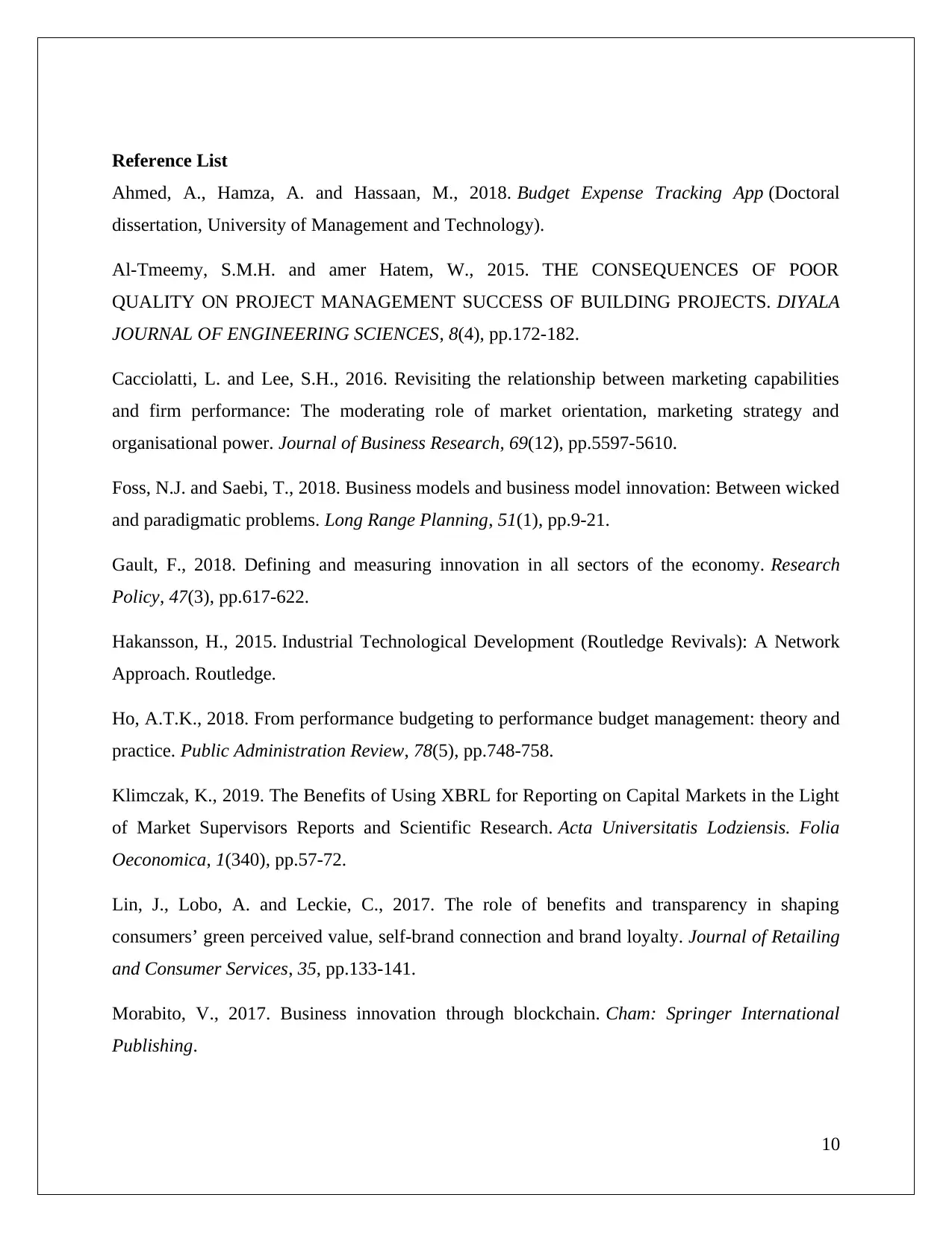
Reference List
Ahmed, A., Hamza, A. and Hassaan, M., 2018. Budget Expense Tracking App (Doctoral
dissertation, University of Management and Technology).
Al-Tmeemy, S.M.H. and amer Hatem, W., 2015. THE CONSEQUENCES OF POOR
QUALITY ON PROJECT MANAGEMENT SUCCESS OF BUILDING PROJECTS. DIYALA
JOURNAL OF ENGINEERING SCIENCES, 8(4), pp.172-182.
Cacciolatti, L. and Lee, S.H., 2016. Revisiting the relationship between marketing capabilities
and firm performance: The moderating role of market orientation, marketing strategy and
organisational power. Journal of Business Research, 69(12), pp.5597-5610.
Foss, N.J. and Saebi, T., 2018. Business models and business model innovation: Between wicked
and paradigmatic problems. Long Range Planning, 51(1), pp.9-21.
Gault, F., 2018. Defining and measuring innovation in all sectors of the economy. Research
Policy, 47(3), pp.617-622.
Hakansson, H., 2015. Industrial Technological Development (Routledge Revivals): A Network
Approach. Routledge.
Ho, A.T.K., 2018. From performance budgeting to performance budget management: theory and
practice. Public Administration Review, 78(5), pp.748-758.
Klimczak, K., 2019. The Benefits of Using XBRL for Reporting on Capital Markets in the Light
of Market Supervisors Reports and Scientific Research. Acta Universitatis Lodziensis. Folia
Oeconomica, 1(340), pp.57-72.
Lin, J., Lobo, A. and Leckie, C., 2017. The role of benefits and transparency in shaping
consumers’ green perceived value, self-brand connection and brand loyalty. Journal of Retailing
and Consumer Services, 35, pp.133-141.
Morabito, V., 2017. Business innovation through blockchain. Cham: Springer International
Publishing.
10
Ahmed, A., Hamza, A. and Hassaan, M., 2018. Budget Expense Tracking App (Doctoral
dissertation, University of Management and Technology).
Al-Tmeemy, S.M.H. and amer Hatem, W., 2015. THE CONSEQUENCES OF POOR
QUALITY ON PROJECT MANAGEMENT SUCCESS OF BUILDING PROJECTS. DIYALA
JOURNAL OF ENGINEERING SCIENCES, 8(4), pp.172-182.
Cacciolatti, L. and Lee, S.H., 2016. Revisiting the relationship between marketing capabilities
and firm performance: The moderating role of market orientation, marketing strategy and
organisational power. Journal of Business Research, 69(12), pp.5597-5610.
Foss, N.J. and Saebi, T., 2018. Business models and business model innovation: Between wicked
and paradigmatic problems. Long Range Planning, 51(1), pp.9-21.
Gault, F., 2018. Defining and measuring innovation in all sectors of the economy. Research
Policy, 47(3), pp.617-622.
Hakansson, H., 2015. Industrial Technological Development (Routledge Revivals): A Network
Approach. Routledge.
Ho, A.T.K., 2018. From performance budgeting to performance budget management: theory and
practice. Public Administration Review, 78(5), pp.748-758.
Klimczak, K., 2019. The Benefits of Using XBRL for Reporting on Capital Markets in the Light
of Market Supervisors Reports and Scientific Research. Acta Universitatis Lodziensis. Folia
Oeconomica, 1(340), pp.57-72.
Lin, J., Lobo, A. and Leckie, C., 2017. The role of benefits and transparency in shaping
consumers’ green perceived value, self-brand connection and brand loyalty. Journal of Retailing
and Consumer Services, 35, pp.133-141.
Morabito, V., 2017. Business innovation through blockchain. Cham: Springer International
Publishing.
10
Secure Best Marks with AI Grader
Need help grading? Try our AI Grader for instant feedback on your assignments.
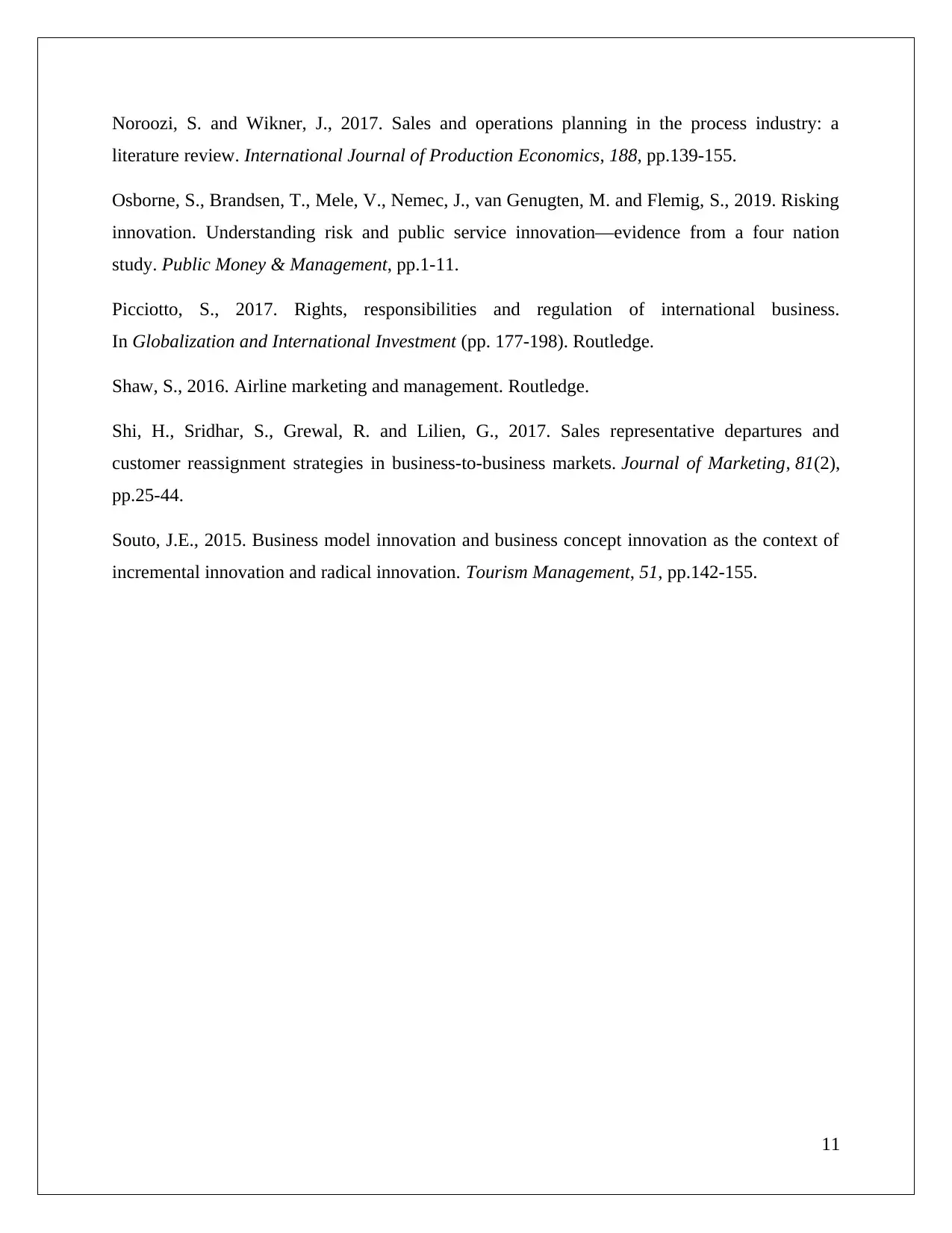
Noroozi, S. and Wikner, J., 2017. Sales and operations planning in the process industry: a
literature review. International Journal of Production Economics, 188, pp.139-155.
Osborne, S., Brandsen, T., Mele, V., Nemec, J., van Genugten, M. and Flemig, S., 2019. Risking
innovation. Understanding risk and public service innovation—evidence from a four nation
study. Public Money & Management, pp.1-11.
Picciotto, S., 2017. Rights, responsibilities and regulation of international business.
In Globalization and International Investment (pp. 177-198). Routledge.
Shaw, S., 2016. Airline marketing and management. Routledge.
Shi, H., Sridhar, S., Grewal, R. and Lilien, G., 2017. Sales representative departures and
customer reassignment strategies in business-to-business markets. Journal of Marketing, 81(2),
pp.25-44.
Souto, J.E., 2015. Business model innovation and business concept innovation as the context of
incremental innovation and radical innovation. Tourism Management, 51, pp.142-155.
11
literature review. International Journal of Production Economics, 188, pp.139-155.
Osborne, S., Brandsen, T., Mele, V., Nemec, J., van Genugten, M. and Flemig, S., 2019. Risking
innovation. Understanding risk and public service innovation—evidence from a four nation
study. Public Money & Management, pp.1-11.
Picciotto, S., 2017. Rights, responsibilities and regulation of international business.
In Globalization and International Investment (pp. 177-198). Routledge.
Shaw, S., 2016. Airline marketing and management. Routledge.
Shi, H., Sridhar, S., Grewal, R. and Lilien, G., 2017. Sales representative departures and
customer reassignment strategies in business-to-business markets. Journal of Marketing, 81(2),
pp.25-44.
Souto, J.E., 2015. Business model innovation and business concept innovation as the context of
incremental innovation and radical innovation. Tourism Management, 51, pp.142-155.
11
1 out of 11
Related Documents
Your All-in-One AI-Powered Toolkit for Academic Success.
+13062052269
info@desklib.com
Available 24*7 on WhatsApp / Email
![[object Object]](/_next/static/media/star-bottom.7253800d.svg)
Unlock your academic potential
© 2024 | Zucol Services PVT LTD | All rights reserved.




